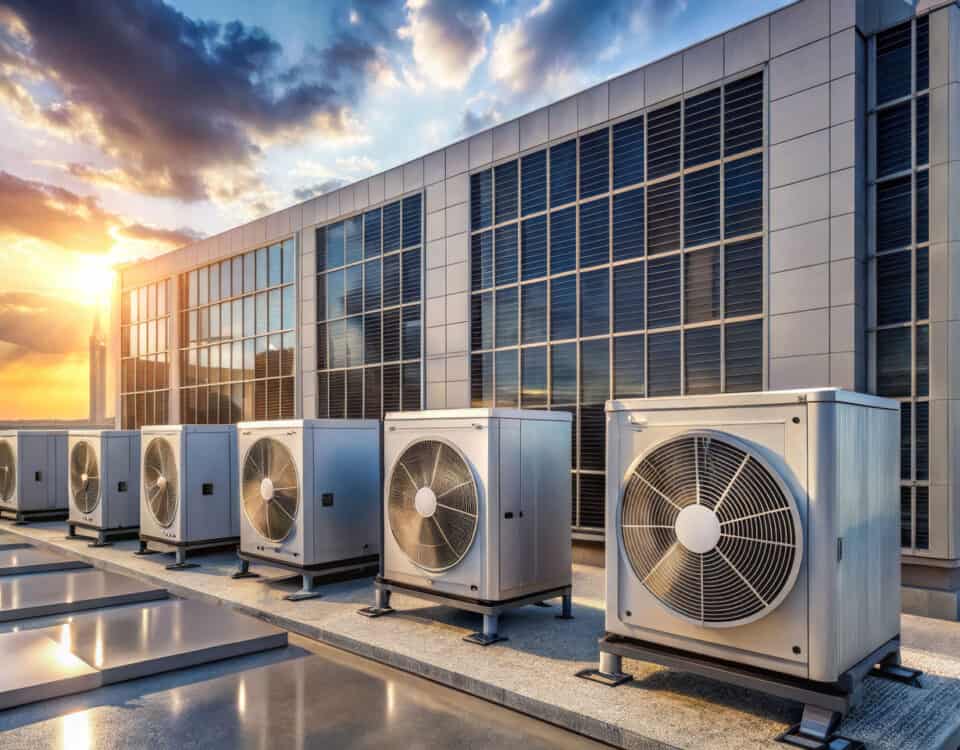
How Does Your Cooling System Affect Your Data Center’s PUE?
July 25, 2024
Green Refrigerants for Green Cooling
August 8, 2024A 2020 study by the American Economic Association surveying 10 million US school children revealed that even a 1°F increase above comfortable indoor temperatures could lead to a 1% reduction in overall learning. This data might sound dramatic, but it underscores the critical role of efficient, reliable school HVAC systems for occupant well-being and student academic success.
Nevertheless, selecting the right HVAC system for a school is a complex task involving multiple considerations and elements that need to be balanced. In this article, we outline the top 5 key factors to prioritize when choosing a school air solution, along with practical recommendations for each consideration.
Key Factors in Choosing Air Conditioning for Schools
1) Cost Effectiveness
Despite the consensus on the importance of a reliable HVAC system for students and staff, upgrading or investing in these systems is often deprioritized for two main financial reasons. First, budget constraints. A 2020 GAO report estimated that modernizing ventilation systems could cost approximately $1 million per building, with new HVAC systems ranging from $30 to $50 per square foot. Second, there is uncertainty about the future ROI. Given the significant expenses involved, including ongoing operation and maintenance costs, school districts hesitate to commit to new HVAC systems without clearly understanding their potential financial benefits.
When selecting a comfort cooling system for schools, consider the following strategies to maximize cost-effectiveness:
- Seek solutions that are eligible for full coverage or refund through the Elementary and Secondary School Emergency Relief (ESSER) Fund.
- Explore cost-saving opportunities through energy-efficient systems, easy installation and maintenance, and reliable and durable equipment that maximize longevity.
- When consulting with a cooling solution provider, gather comprehensive information on potential ROI to justify the investment.
2) System’s Flexibility
Schools have diverse ventilation and temperature requirements due to various factors, such as the specific areas within the school (classrooms, gyms, labs, restrooms, cafeteria, etc.), fluctuating traffic patterns, the number of occupants in each room, occupancy duration, and school break periods. These unique needs make it impractical to enforce the same indoor air quality (IAQ) and temperature control settings throughout the entire school area.
Therefore, when choosing a comfort cooling system for your school, it’s recommended to select solutions that offer adaptability and flexibility to meet diverse cooling needs. This approach will ensure that school areas are not over-cooled unnecessarily, allowing the HVAC system to operate more strategically, efficiently, and economically. Look for modern comfort cooling systems that feature:
- Modular designs
- AI algorithms that can sense the environment and automatically adjust temperature and airflow.
- Versatility in cooling capacities
3) Maintenance Considerations
Regular maintenance is crucial for ensuring the long-term reliability and efficiency of a comfort cooling system. Routine upkeep keeps the HVAC system clean and functioning optimally, which enhances performance and maintains energy efficiency, thereby keeping utility bills relatively low. Additionally, regular maintenance can address issues before they become major problems, saving time and money on repairs or replacements. Moreover, consistent inspections can identify and mitigate potential safety hazards, such as gas leaks, ensuring a safer learning environment.
Given this critical need, it’s recommended to choose a comfort cooling system that facilitates user-friendly upkeep, both in terms of accessibility and ease. Features that can simplify maintenance tasks and problem detection include:
- Slide-out filter designs
- Removable fan assemblies
- Accessible panels
- Clear error code displays
If you prefer to hire a third-party service provider for maintenance, make sure they provide:
- 24/7/365 serviceability
- Prompt response times
- Comprehensive maintenance plans
4) Environmental and Health Considerations
HVAC systems play a crucial role in maintaining the health and well-being of school occupants. Proper ventilation and air filtration help reduce the spread of airborne pathogens, allergens, and pollutants, contributing to a healthier learning environment. Additionally, as climate change becomes an increasingly pressing issue, schools face mounting pressure to reduce their carbon footprint. Environmental regulations are expected to become more stringent, compelling educational institutions to comply with stricter energy efficiency and emissions standards.
These dual considerations—health and environmental impact—are increasingly critical in selecting and operating school HVAC systems, making it essential to prioritize systems that effectively address these concerns. Look for solutions that:
- Employ advanced cooling technologies and incorporate energy-efficient components, such as heat pumps.
- Integrate heat recovery features to further enhance efficiency, for instance, by repurposing waste heat.
- Utilize green refrigerants with lower global warming potential (GWP) to substantially lessen environmental impact and pose fewer risks to human health.
5) Seamless Integration with School Life
The integration of comfort cooling systems into the educational environment is a critical consideration that extends beyond mere functionality. A well-integrated system ensures that students can focus on their studies without being distracted by noise or disruptions from maintenance activities. Proper integration also simplifies operations for school administrators and maintenance teams, allowing them to focus on other essential tasks rather than managing complex HVAC issues. By prioritizing HVAC solutions that blend effortlessly into the school environment, schools can create a comfortable atmosphere conducive to learning and overall well-being.
To ensure seamless integration and compatibility with schools’ existing infrastructure and cooling systems, consider the following strategies when selecting a comfort cooling solution. Look for systems with:
- Comprehensive self-diagnostic features that minimize operational disruptions and enable quick, easy troubleshooting.
- Quiet operation to help children stay focused in the classroom.
- Versatile installation options for both indoor and outdoor units, featuring compact and architecturally mindful designs that blend with the school building’s aesthetics.
- Flexible designs that can adapt to different school layouts and requirements.
- Scalability capabilities to accommodate changes in the school’s needs.
Every School is Different, but the Fundamentals Remain the Same
While sharing a common purpose, educational facilities vary significantly in factors such as student population, building age, and climate zone, so there’s no universal HVAC solution suitable for all schools. That said, the “best” solution for each school still shares some of the main characteristics that make a school HVAC system cost-effective, adaptable, easily serviced, compatible, and green.
At AIRSYS, we are the preferred cooling and human comfort solution provider for K-12 campuses. Our industry-leading and innovative school air solutions — Backpack™ and Focus IQ™ — incorporate all five crucial aspects discussed above into one comprehensive comfort cooling system, including 24/7/365 maintenance support and troubleshooting for units. To learn more about our offerings, contact us online or request a consultation. Our expert teams are ready to answer your questions and tailor our cooling solutions to meet your school’s specific needs.
Sources:
https://www.gradientcomfort.com/blogs/news/hvac-systems-for-schools
https://jaga.co.uk/blog/key-considerations-when-selecting-a-ventilation-system-for-schools
https://www.biddle-air.co.uk/news/choosing-the-correct-hvac-system-for-your-educational-facility
https://schmidt-arch.com/how-to-choose-the-right-hvac-system-for-a-k-12-school/
https://learningpolicyinstitute.org/blog/covid-hvac-systems-essential-resource




